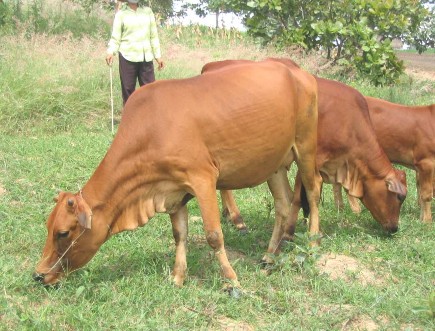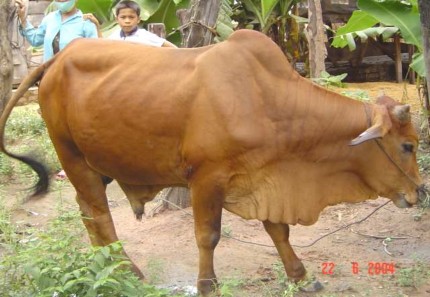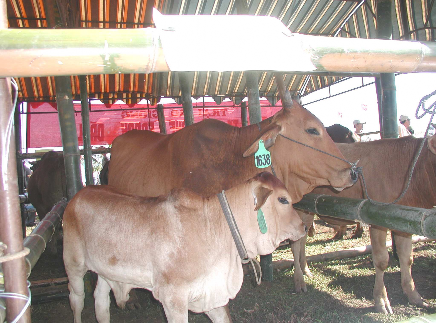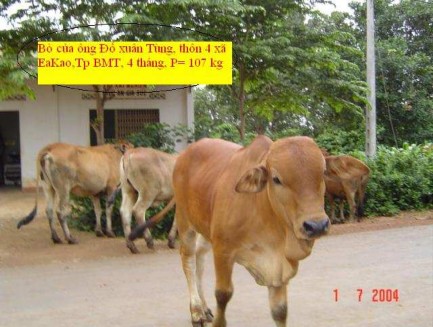growth, and milk production of first calf heifers sired by seven breeds and raised on different levels of nutrition”, J. Anim. Sci, 76, pp. 1511 – 1522.
95. Gompertz (1825), Gompertz function, Truy cập ngày 25 tháng 5 năm 2007 http://en.wikipedia.org/wiki/Gompertz_curve
96. Gottardo F., Ricci R., Preciso S., Ravarotto L. and Cozzi. G (2004), “Effect of the manger space on welfare and meat quality of beef cattle”. Livestock Production Science, 89, pp. 277 – 285.
97. Hocquette J. F., Graulet B., Castiglia Delavaud., Bornes F., Lepetis N. and Ferre P. (1996), Insulin- sentive glucose transport transcript levels in culf muscules assessed with bovine GLUTT4 cDNA fracmen
98. Hofmann K. (1988), “pH - A quality cricterition for meat”,
Fleischwirtsch, 68, pp. 65 – 69.
99. Honikel K. O. (1997), “Reference methods supported by OECD and their use in Mediterranean meat products”, Food Chemistry, Vol, 59, pp. 573 – 592.
100. Holroyd (1988), “Reproductive performance of 50% Bos indicus cattle grazing the Mitchell grasslands of north Queensland 1973 – 80”, Proc. Aust, Rangle, Soc, 5, pp. 49 – 53.
101. Jaturasitha S., Norkeaw R., Vearasilp T., Wicke M. and Kreuzer M. (2009), “Carcass and meat quality of Thai native cattle fattened on Guinea grass (Panicum maxima) or Guinea grass – Legume (Stylosanthes guianensis) pastures”, Meat Science, 81, pp. 155 – 162.
Có thể bạn quan tâm!
-
 Màu Sắc Của Thịt Bò Ở Các Thời Điểm Khác Nhau Sau Giết Thịt
Màu Sắc Của Thịt Bò Ở Các Thời Điểm Khác Nhau Sau Giết Thịt -
 Mô Hình Sinh Trưởng Của Bò Lai Hướng Thịt Bằng Hàm Gompertz Có Hệ Số Xác Định Của Phương Trình Hồi Quy Cao:
Mô Hình Sinh Trưởng Của Bò Lai Hướng Thịt Bằng Hàm Gompertz Có Hệ Số Xác Định Của Phương Trình Hồi Quy Cao: -
 Phạm Thế Huệ (1997), Nghiên Cứu Một Số Tính Trạng Năng Suất Chủ Yếu Của Bò Địa Phương Và Bò Lai F1 (Red Sindhi × Bò Địa Phương) Tại Đăk Lăk, Luận
Phạm Thế Huệ (1997), Nghiên Cứu Một Số Tính Trạng Năng Suất Chủ Yếu Của Bò Địa Phương Và Bò Lai F1 (Red Sindhi × Bò Địa Phương) Tại Đăk Lăk, Luận -
 Khả năng sinh trưởng, sản xuất thịt của bò lai sind, F1 brahman × lai sind và F1 charolais × lai sind nuôi tại Đăk Lăk - 20
Khả năng sinh trưởng, sản xuất thịt của bò lai sind, F1 brahman × lai sind và F1 charolais × lai sind nuôi tại Đăk Lăk - 20 -
 Khả năng sinh trưởng, sản xuất thịt của bò lai sind, F1 brahman × lai sind và F1 charolais × lai sind nuôi tại Đăk Lăk - 21
Khả năng sinh trưởng, sản xuất thịt của bò lai sind, F1 brahman × lai sind và F1 charolais × lai sind nuôi tại Đăk Lăk - 21
Xem toàn bộ 170 trang tài liệu này.
102. Johansson I. (1968), Genetic and animal breeding, Oliver and Goyd, Ediburrg, London, pp. 364 – 367.
103. Kearl L.C. (1982), Nutrien Requirenments of Ruminants in Developing Countries. International Feedstuff Institute, Utah Agricultural Experiment Station. Utah State University, Logan, USA.
104. Kenneth Luvenberg (1944), “A method for the Solution of certain Non – Linear Problems in Least Square” The Quartly of the Applied Methematics, 2, pp. 164 – 168.
105. Kohn F., Sharifi A. R. and Simianer H. (2007), “Modeling the growth of Goettingen Minipig”, Journal of Animal Science, 85, pp. 84 – 92.
106. Koots K. R., Gibson J. P. Smith C. and Wilton J. W. (1994), “Analyses of published genetic parameter estimates for beef production traits. 1. Heritability”, Animal Beeding abstracts, 62, pp. 309 – 388.
107. Koots K. R., Gibson J. P. and Wilton J. W. (1994), “Analyses of published genetic parameter estimates for beef production trait. 2. Phenotypic and Genetic correlations”, Animal Breeding abstracts, 62, pp. 825 – 853.
108. Lambe N. R., Navajas., Simm G. and Bunger (2006), “A genetic investigation of various growth models of lambs of two constrasting breeds”, J. Anim Sci, 84, pp. 2642 – 2654.
109. Lawrence R. W., Doyle J., Eliott R., Loxton I. and Mc Meniman J. P. (2006), “The efficacy of a vitamin D3 metabolite for improving the myofibrillar tenderness of meat from Bos indicus cattle”, J. Meat. Sci, 72, pp. 69 – 78.
110. Li C. B., Chen Y. J., Xu X. L., Huang M., Hu T. J. and Zhou G. H. (2006), “Effects of lawvoltage electrical stimulation and rapid chilling on meat quality characteristics of Chinese Yellow crossbred bulls”, J. Meat Sci, 72, pp. 9 – 17.
111. Mandell I. B., Buchanan – Smith J. G. and Campbell C. P. (1998), “Effect of forage vs grain feeding on carcass characteristics, fatty acid composition, and beef quality in Limousin – cross steers when time on feed is controlled”, J. Anim Sci, 76, pp. 2619 – 2630.
112. NRC (2002), The nutrient requirements of beef cattle, Washington DC.
113. Ouali A. (1991), “Sensory quality of meat as affected by muscle biochemistry and modern technologie”, In, L.O. Fiems, B. G. Cottyn et D.I. Demeyer (eds), Animal biotecnology and the quality of meat production (Elsevier, Amstecdam), pp. 85 - 105.
114. Page. J. K., Wulf. D. M. and Schwotzer (2001), “A survey of beef muscle color and pH”, J. Anim. Sci, 76, pp. 678 – 687.
115. Peacock F. M., Koger M., Palmer A. Z., Carpenter J. W. and Olson T. A. (1982), “Additive breed and heterosis effects for individual and maternal influence on feedlot gain and carcass traits of Angus, Brahman, Charolais and cross steers”,Journal of Animal Science, 55, pp. 797.
116. Perry T. W. (1990), “Dietary nutrient allowance for beef cattle”.
Feedstuffs – Reference issue, 62, 31, pp. 46 – 56.
117. Phocas F. and Laloe. D. (2004), “Genetic parameters for birth and weaning traits in french specialized beef cattle breeds”, Livestock production Science, 89, pp. 121 – 128.
118. Preston T. R., Willis M. B. and Elias A. (1967), Intensive Beef Production from Sugar cane.
119. Rao M. K., Nagarcenkar R. and Sharma K. N. S. (1977), “Evaluation of performance of Brownswiss × Zebu crosses for early trait, Indian, J.Anim. Sci, 45, pp. 514-520.
120. Realini C. E., Duckett S. K., Brito G. W., Dalla Rizza. M. and De Mattos
D. (2004), “Effect of pasture vs concentrate feeding with or without antioxidants on carcass characteristics, fatty acid composition, and quality of Uruguayan beef”, Meat Science, 66, pp. 567 – 577.
121. Realini C. E., Duckett S. K., Hill N. S., Hoveland C. S., Lyon B. G., Sackmann J. R. and Gillis M. H. (2005), “Effect of endophyte type on carcarss traits, meat quality, and fatty acid composition of beef cattle grazinh tall fescue”, J. Anim. Sci, 83, pp. 430 – 439.
122. Sansory R., Aart G. and Leng R.A. (1998), “ MUB as a multinutrient supplement for ruminants”, Sugar cane as feed, Editors, Sosoucy. R; Aart. G; Preston T.R. Rome, pp. 263 – 279.
123. Setthakul J., Opatpatanakit Y., Sivapirunhep P. and Intrapornudom P. (2008), “Beef quality under production systems in Thailand”, Preliminary remarks.
124. Shakelford S. D., Koohmaraie M., Wheeler T. L., Cundiff L.V. and Dileman M. E. (1994), “Effect of biological type of cattle on the incidence of the dark, firm, and dry condition in the longissimus muscle”. J. Anim. Sci, 72, pp. 337 – 343.
125. Shakelford S. D., Wheeler T. L. and Koohmaraie M. (1997), “Tenderness classification of beef: I. Evaluation of beef longissimus shear force at 1 or 2 days as a predictor of aged beef tendness”, J. Anim. Sci, 75, pp. 2417 – 2422.
126. Shull G. H. (1952), Beginnings of the heterosis concept, Iowa State College Press.
127. Silva A. T., Greenhalgh J. D. F. and Orskov E. R. (1989), “Influence of ammonia treatment and supplementation on the intake, digestibility and weight gain of sheep and cattle on barley straw diet”, Anim. Prod, 48, pp. 99-108.
128. Simm G. (1998), Genetics improvement of cattle and sheep, Farming press, Ipswich.
129. Smith G. C., Duston T. R., Hostetler R.L. and Carpenter Z. I. (1976), “Fatner, rate chilling and tenderness of lamb”, J. Food. Sci, 41, pp. 748 - 756
130. Splan R. K., Cundiff L. V., Dikeman M. E. and Van Vleck L. D. (2002), “Estimates of parameters between direct and maternal genetic effects for weaning weight and direct genetic effects for carcass traits in crossbred cattle”, J. Anim. Sci, 80, pp. 3107 – 3111.
131. Nguyen Van Thuong (1995), “Some results of study of beef and dairy cattle in Viet Nam”, Exploring approaches to research in the animal sciences in Viet Nam, pp. 46 – 49.
132. Tyler (1998), “Liveweight gain of Brahmnan cross heifers supplemented during the dry season with fortified molasses”, Beef cattle performmance in northern Australia (a summerry of recent research), Department of Primari industries, Queensland, Brisbane, pp. 100.
133. Williamson G. and Payner W. J. A. (1978), An introduction to animal husbandry in the tropics, Third edition, Longman, London and New York, pp. 210 – 215.
134. Wood J.D., Kempster A. J. and David P. J. (1987), “Observation on carcass and meet quality in pig”, Animal Prod, 44, pp. 448.
135. Wulf D. M., Emnett R. S., Leheska J. M. and Moeller S. J. (2002), “Relationships among glycolytic potention, dark, cutting (dark, firm and dry) beef, and cooked beef palatability”, J. Anim. Sci, 80, pp. 1895 - 1903
136. Yang X. Y., Albrecht E., Ender K., Zhao R. Q. and Wegner J. (2006), “Computer image analysis of intramuscular adipocytes and marbling in the longgissmus muscle of cattle”, J. Anim Sci, 84, pp. 3251 – 3258.
137. Zhou G. H., Liu L., Xiu X. L., Jian, Wang L. Z., Sun B. Z. and Tong B.
S. (2001), “Productivity and carcass characsteristics of pure and crossbred Chinese Yellow cattle”, Meat Science 58, pp. 359 -362.
C Tiếng Pháp, Đức
138. Alder D. (1980), Estimattion des volumes et accroisement des peulements foresties, Vol 2, FAO, Rome, pp. 30 – 40.
139. Cabaraux J. F., Hornick J. L., Dufransne I., Clinquart A. and Istasse L. (2003), “Enrissement de la femelle de forme Blanc – Bleu Belge cularde: performances zootechnicques, caratéristiques de la carcasse et qualité de la viande”, Ann, Méd, Ved, 147, pp. 423 – 431.
140. Clinquar A., Leroy B., Dotreppe. O., Hornick J. L., Dfrasne I. and Istasse L. (2000), Les facteurs de production qui influence la qualité
de la viande des bovines Blanc Bleu belge.
141. Dufrasne I. (1994), “Contribution à l’étude de différents paramètres influencant l’utilisation de la prairie permanente par la vache traite, la vache allaitante et le taurillon”, Thèse présentée envue de l’obtention du grade d’Agrégée de l’Enseignement Supérieur, Université de Liège, pp. 272.
142. Honikel K. O. (1998), “Physikalische MeBmethoden zur Erfassung der Fleischqualitat”, Qualitat von Fleisch und Fleischwaren, Band 2, pp. 696 – 700.
143. Institus de l’Elevage (2006), “La composante structurelle et l’acidification du muscle (pH)”, Le point sur la couleur de la viande bovine, Fiche 3, pp. 1-5.
144. Monin G. (1988), “Stress d’abattage et qualite’s de la viande”, Rec, Me’d, Ved, 164, pp. 835 – 842.
PHỤ LỤC

BÒ CÁI LAI SIND

BÒ ĐỰC LAI SIND

BÊ LAI (BRAHMAN × LAISIND), TẠI HỘI CHỢ BÒ HUYỆN EAKAR, TỈNH ĐĂK LĂK

BÊ LAI (BRAHMAN × LAISIND), 4 THÁNG TUỔI ĐẠT 107 KG





